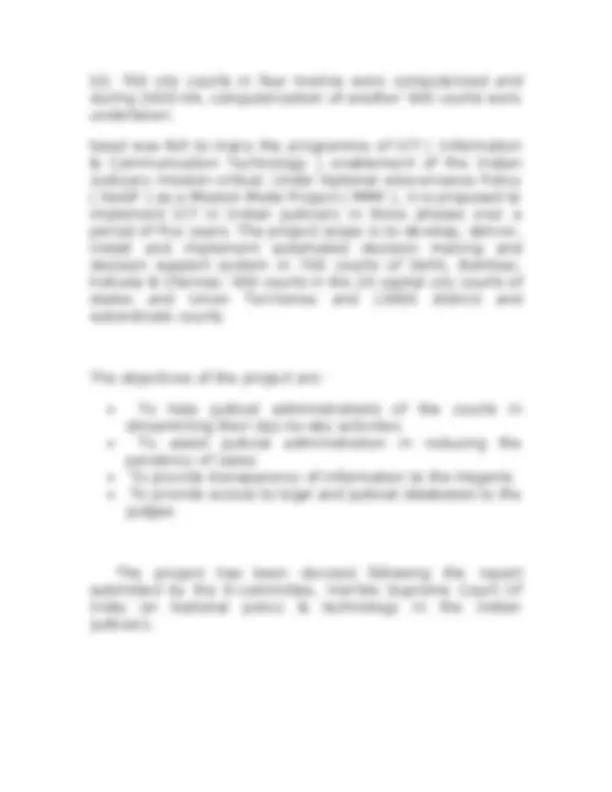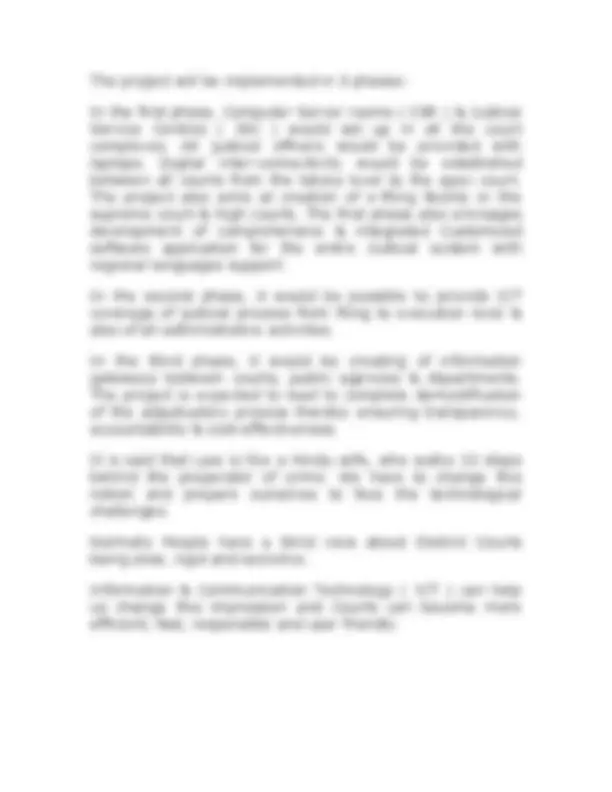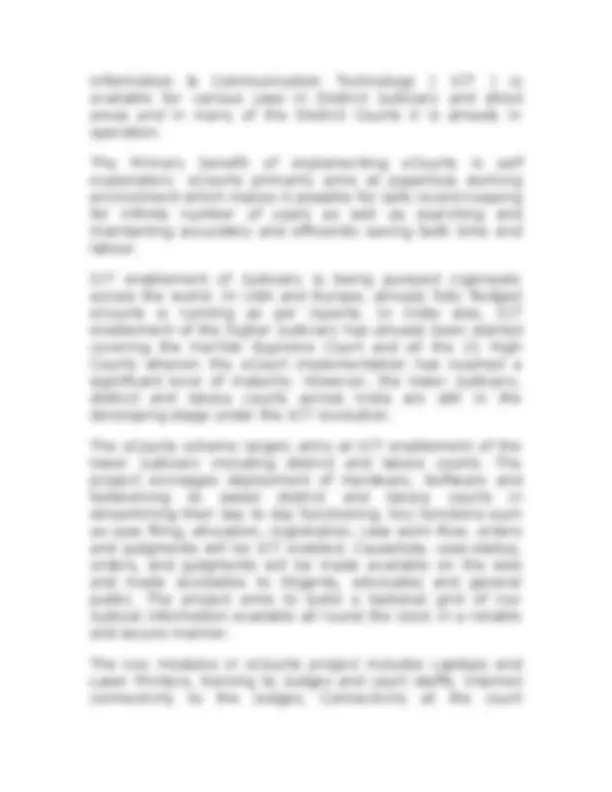








Study with the several resources on Docsity

Earn points by helping other students or get them with a premium plan


Prepare for your exams
Study with the several resources on Docsity

Earn points to download
Earn points by helping other students or get them with a premium plan
Community
Ask the community for help and clear up your study doubts
Discover the best universities in your country according to Docsity users
Free resources
Download our free guides on studying techniques, anxiety management strategies, and thesis advice from Docsity tutors
The inception of the concept of e-court
Typology: Assignments
1 / 10

This page cannot be seen from the preview
Don't miss anything!







Indian Judiciary is in urgent need of re-engineering its processes, optimize the use of its human resources and bring about change management by harnessing the potentiality of the available Information and Communication Technology (ICT) to its fullest extent. The objective of this exercise is to enhance the Judicial productivity both qualitatively and quantitatively as also make the Justice delivery system affordable, accessible, cost effective, transparent and accountable. Similar objectives have been achieved in other parts of the world by use of technology but in India though its manpower is known for its technology expertise, the ICT benefits could not be fully explored and utilized in public service sectors like Judiciary and other organs of the State. The Chief Justice of India (CJI) made a proposal to the Central Government under the letter dated 05.07. addressed to the Minister of Law and Justice for constitution of an E-Committee to assist him in formulating a National Policy on computerization of Indian Judiciary and advise technological, communication and management related changes. Appreciating the desirability of constitution of such a Committee, the Union Cabinet approved the proposal. Consequently, office order dated 28.12.2004 was issued by the Ministry of Law and Justice (Department of Justice) constituting the E-Committee under the Chairmanship of Dr. Justice G.C. Bharuka, a retired Judge of the High Court of Karnataka, with three other specialist members. The E- Committee was inter alias required to formulate a National Policy on computerization of justice delivery system and to draw up an action plan with appropriate phasing for time bound implementation. This Committee is also required to concurrently monitor and evaluate the action plan on periodic basis.
The E-Committee prepared the Report on Strategic Plan for Implementation of Information and Communication Technology in Indian Judiciary which was presented to the CJI on 11.05.2005. The Judges of the Supreme Court, senior advocates and senior executives from Department of Justice, Ministry of Communication and Information Technology as also NIC were present on the occasion. The Report of the E-Committee was circulated by the Hon'ble CJI to the Chief Justices of all the High Courts requesting them to consider the proposals contained in the Report and send suggestions as may be found advisable. Copies of the Report had also been sent to the leading jurists, academicians, concerned Ministers and ministries of the Union Government including NIC. The Report was made available to the Law Ministers of all the States as well at the Law Ministers Conference held at Simla on 11.06.2005 and elaborate discussions were held thereon. E-Committee also held detailed discussions with large section of ICT related organizations, service providers, research and development experts and leading manufacturers to ascertain the existing status of the technology. Its use in the context of court related processes, pricing, availability, security, implementation, scalability, sustainability, pace of change and support systems. Based on the inputs received from persons having expertise in diverse domains relevant for change management in Indian Judiciary, the E-Committee has framed the present National Policy and Action Plan for its implementation during a span of five years from the date of its effective commencement. The Indian judiciary comprises of nearly 15,000 courts or more situated in approximately 2,500 court complexes throughout the country. In the Indian Judiciary, efforts for computerization of some of its processes have been going on since 1990. From 2001-
The project will be implemented in 3 phases- In the first phase, Computer Server rooms ( CSR ) & Judicial Service Centres ( JSC ) would set up in all the court complexes. All judicial officers would be provided with laptops. Digital inter-connectivity would be established between all courts from the taluka level to the apex court. The project also aims at creation of e-filing facility in the supreme court & high courts. The first phase also envisages development of comprehensive & integrated Customized software application for the entire Judicial system with regional languages support. In the second phase, it would be possible to provide ICT coverage of judicial process from filing to execution level & also of all administrative activities. In the third phase, it would be creating of information gateways between courts, public agencies & departments. The project is expected to lead to complete demystification of the adjudicatory process thereby ensuring transparency, accountability & cost-effectiveness. It is said that Law is like a Hindu wife, who walks 10 steps behind the preperator of crime. We have to change this notion and prepare ourselves to face the technological challenges. Normally People have a blind view about District Courts being slow, rigid and secretive. Information & Communication Technology ( ICT ) can help us change this impression and Courts can become more efficient, fast, responsible and user friendly.
Information & Communication Technology ( ICT ) is available for various uses in District Judiciary and allied areas and in many of the District Courts it is already in operation. The Primary benefit of implementing eCourts is self explanatory. eCourts primarily aims at paperless working environment which makes it possible for safe record keeping for infinite number of years as well as searching and maintaining accurately and efficiently saving both time and labour. ICT enablement of Judiciary is being pursued vigorously across the world. In USA and Europe, already fully fledged eCourts is running as per reports. In India also, ICT enablement of the higher Judiciary has already been started covering the Hon’ble Supreme Court and all the 21 High Courts wherein the eCourt implementation has reached a significant level of maturity. However, the lower Judiciary, district and taluka courts across India are still in the developing stage under the ICT revolution. The eCourts scheme largely aims at ICT enablement of the lower Judiciary including district and taluka courts. The project envisages deployment of Hardware, Software and Networking to assist district and taluka courts in streamlining their day to day functioning. Key functions such as case filing, allocation, registration, case work-flow, orders and judgments will be ICT enabled. Causelists, case-status, orders, and judgments will be made available on the web and made accessible to litigants, advocates and general public. The project aims to build a National grid of key Judicial information available all round the clock in a reliable and secure manner. The key modules in eCourts project includes Laptops and Laser Printers, training to Judges and court staffs, Internet connectivity to the Judges, Connectivity at the court
Site preparation under eCourts project covers building of ICT room in the court complexes. ICT room consists of Computer Server Room ( CSR ) and Judicial Service Center ( JSC ). DG sets are already being provided for power backup in the ICT room. One more major aspect to be covered under eCourts project is Videoconferencing technique through which courts will be connected to the Jail by ISDN lines and at both ends a camera unit and a display unit will be provided with recording facility at the court’s end. Under- trial is produced at the Jail end. The Judge, Lawyers and witnesses etc. remain present in the court and regular trial is conducted. The judicial remand of the under-trial can also be extended without physically producing him in the court. The benefits of Videoconferencing includes –
witnesses, stage of trial, next date of hearing and advocate’s name etc. Data is updated on daily basis without fail. The main benefits of proper Data management approach includes daily causelist and court diary generation, periodical statements, automatic marking of cases, year wise judge-wise casetype-wise pending case statements generation, provisions are also made to generate automated summons, warrants and notice generation all at the press of a single button. Another area has been covered under the eCourts project is having Websites for each courts which helps litigants and lawyers to check the daily causelists, judgments, and various upto date informations regarding the district courts. The future aspect of eCourts project includes e-filing of cases, online enquiries, online court fee payments etc. For Data management, already the Application software developed by NIC called Case Information System ( CIS ) Software for District and sub-ordinate courts has been tested in many of the major pilot sites and is being fully functional now. In North-East India, under Gauhati High Court, Kamrup District court of Assam is being considered as the pilot site under eCourts project. The Site preparation work including ICT room construction, deployment and installation of various Hardware and Networking items including Touch screen Kiosk information systems, implementation of CIS software are already done in various court complexes in Kamrup district as well as in various district courts. Various objectives under eCourts project has already been attained in Kamrup district Judiciary. The Judges and court staffs are being trained on various modules of eCourts project. The Judges are being
eCourts will prove to be a landmark in the life of the people and transform their anticipations into reality. Collected and Composed by- Sri Kishor Talukdar, Systems Officer (eCourts), Kamrup District Judiciary, Assam. Email: guwahati.session@gmail.com